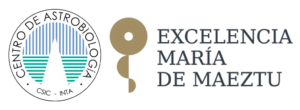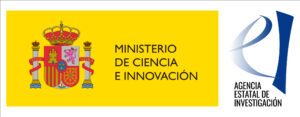MdM DESCRIPTION
Grant MDM-2017-0737 (UNIDAD DE EXCELENCIA MARÍA DE MAEZTU, “Assessing the feasibility of life as a universal phenomenon through planetary exploration” funded by MCIN/AEI/
10.13039/501100011033


CENTRO DE ASTROBIOLOGÍA (CAB, CSIC-INTA) HAS RECEIVED THE “MARÍA DE MAEZTU EXCELLENCE UNIT“ DISTINCTION IN THE 2017 CALL OF THE MINISTRY OF SCIENCE, INNOVATION AND UNIVERSITIES, WITH THE PROGRAMME “ASSESSING THE EMERGENCE OF LIFE AS A UNIVERSAL PHENOMENON THROUGH PLANETARY EXPLORATION”, FOR THE PERIOD 1 JULY 2018 TO 30 JUNE 2022 (extended until 30 June 2023).
This accreditation, which is part of the State Sub-Programme for Institutional Strengthening, recognises the relevance of the cutting-edge scientific research carried out at CAB and its international leadership in the field of space sciences.
Centro de Astrobiología (CAB) is a joint research center of the Spanish National Research Council (CSIC) and the National Institute of Aerospace Technology (INTA). Created in 1999, it was the world’s first center dedicated specifically to astrobiological research and the first non-US associate member of NASA’s Astrobiology Institute (now the NASA Astrobiology Program). It is an interdisciplinary research center whose main objective is to study the origin, presence and influence of life in the universe. Scientists specialising in a wide range of fields such as biology, chemistry, geology, physics, genetics, ecology, astrophysics, planetology, engineering, mathematics and computer science work at the centre. Since its creation it has stood out for the high quality of its scientific results, its ambitious strategic programmes and the dissemination of its results. This has made it a leading international multidisciplinary centre, which in 2017 was distinguished by the Ministry of Science and Innovation as a “María de Maeztu” Unit of Excellence.
CAB has led the development of the REMS, TWINS and MEDA instruments, three environmental stations operating on Mars since August 2012, November 2018 and February 2021, respectively; as well as the science of the RLS Raman instrument, which will be sent to Mars in 2022. In addition, since its inception, the center has been developing the SOLID instrument, aimed at the search for life in planetary exploration. Likewise, CAB participates in different missions and instru,ments of great astrobiological relevance, such as CARMENES, CHEOPS, PLATO, BepiColombo, the MIRI and NIRSpec instruments at JWST and the HARMONI instrument at ESO’s Extremely Large Telescope (ELT).
The programme, endowed with five hundred thousand euros per year for four years, will strengthen our scientific-technical capabilities and promote synergies that attract resources and increase research potential at international level for the period 2018-2021.
CAB is also a member of the SOMMa, alliance, which brings together Spanish cutting-edge research centres and units.
List of María de Maeztu Units and Severo Ochoa Centres
- Planetology and Habitability: Characterisation and evolution of potentially habitable environments in the Solar System. Extreme environments on Earth as planetary analogues and atmospheres.
- Molecular Evolution: Studying the origin, evolution and adaptation of life, from prebiotic chemistry to microbial diversity and metabolisms in extreme environments. The fingerprints of life and how to find them.
- Advanced instrumentation: Development of instrumentation for simulation, planetary exploration, remote observation. Exploration of Mars and icy worlds.
- Astrophysics and Astrochemistry: Studying the formation and evolution of the elements, the interstellar medium, stars and planets, or the cometary chemistry that feeds planets. Search for and characterisation of exoplanets.
The scientific and technological priorities associated with the María de Maeztu programme, which require strong synergies and an interdisciplinary research environment, are:
- In situ exploration of planetary objects in the Solar System: Mars, Mercury, the Jupiter system and comets and asteroids. Coordinator: José Antonio Manfredi
- Identification of key biomarkers in terrestrial analogues of other planetary environments, in the Solar System and exoplanets. Coordinator: Felipe Gómez
- Laboratory simulation to characterise planetary and cometary environments. Coordinator: Guillermo Muñoz Caro
- Remote search and characterisation of exoplanets, including the formation and atmospheric studies of exoplanets and brown dwarfs. Coordinator: David Barrado
Direction of the Centre
Director: Prof. Victorino Parro García
Deputy Director: Dr. Francisco Najarro de la Parra,
Guarantors
Dr. Carlos Briones Llorente
Dr. Luis Colina
Dr. Felipe Gómez Gómez
Dr. Alberto González Fairén
Dr. Miguel Mas Hesse
Dr. Guillermo Muñoz-Caro
Dr. José Antonio Rodríguez Manfredi
Dra. María-Paz Zorzano Mier
Heads of Department
Dr. Felipe Gómez Gómez, Planetology and Habitability Dept.
Dr. Ester Lázaro, Molecular Evolution Dept.
Dr. Miguel Mas Hesse, Astrophysics Dept.
Dr. Eduardo Sebastián Martínez,
Advanced Instrumentation Dept.
Prof. Dr. Paola Caselli, Director and Scientific Member of the Max Planck Institute for Extraterrestrial Physics, Garching.
Prof. Gian Gabriele Ori, Director of the International Research School of Planetary Sciences, IRSPS, (Pescara, Italy) and Full Professor (Professore Ordinario) of Geology at the Universita’ d’Annunzio (Pescara, Italy).
Dr. Muriel Gargaud, CNRS Research Director, Laboratoire d'Astrophysique de Bordeaux, Université Bordeaux.
Dr. Rosaly Lopes, Senior Research Scientist at NASA's Jet Propulsion Laboratory, Earth and Space Sciences Division, California.
Prof. Michel Mayor, Premio Nobel de Física 2019, Université de Genève.
Dr. Chris McKay, Planetary Geologist, Space Science Division - NASA Ames Research Center, California.






